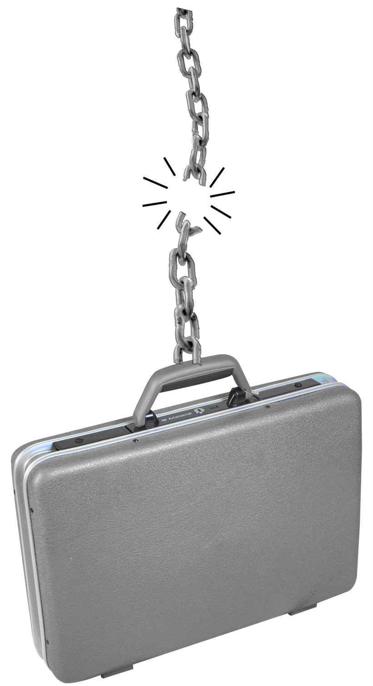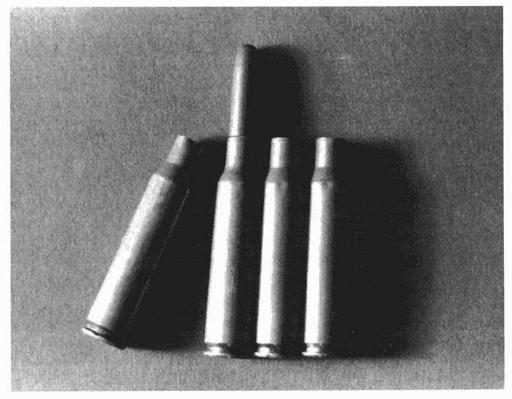Impossible: The Case Against Lee Harvey Oswald (49 page)
Read Impossible: The Case Against Lee Harvey Oswald Online
Authors: Barry Krusch
Tags: #Non-Fiction, #History

BOOK: Impossible: The Case Against Lee Harvey Oswald
12.32Mb size Format: txt, pdf, ePub
There is
no testimony on the record
that can verify that the shells which were discovered on the floor of the Texas School Book Depository were the shells exhibited by the Warren Commission, the ones which evidence shows was fired from Oswald’s rifle!
And that would lead us to our final deductive syllogism which would prove, inevitably, the main thesis of this book, that there is no legitimate case against Lee Harvey Oswald. This is because a case can be no stronger than the weakest link supporting it.
Imagine a case, a heavy one, suspended thirty feet above the ground by a chain. Now, cut one of the links out. Note that the case comes crashing to the ground:
If the confidence level for any essential element of the case is
zero
, that is, in effect, like removing one of the links of the chain.
And we can see, deductively, that
in fact
one of the key links in the chain has been completely removed, leading to the inevitable crash. There are two syllogisms which demonstrate this, the conclusion of the first syllogism being used as a premise of the second.
The first syllogism is as follows:
IF it is in fact true that the confidence level for a proposition or element or sub-element of a case starts at zero until proven, AND
IF it is in fact true that an essential sub-element of The Case Against Oswald is that the Texas School Book Depository shells be identical with those exhibited by the Warren Commission, AND
IF it is in fact true that Day’s is the only testimony capable of linking the Texas School Book Depository shells to the shells possessed and exhibited by the Warren Commission, AND
IF it is in fact true that the “Q” numbers map onto the Commission Exhibit numbers of the shells as the Warren testimony indicated, AND
IF it is in fact true that as a consequence of this mapping, Day’s testimony not only fails to prove the fact for which it is offered, but actually proves the opposite, AND
IF it is in fact true that the only way to escape Day’s testimony is to
invalidate
it, AND
IF it is in fact true that invalidated testimony has no legal force and effect, as if it had not even existed,
THEN the confidence level for the sub-element that ties the Texas School Book Depository shells to the bullets exhibited by the Warren Commission remains at ZERO.
The second syllogism is related to the entire case:
IF it is in fact true that the confidence level for the sub-element that ties the Texas School Book Depository shells to the bullets exhibited by the Warren Commission is zero, AND
IF it is in fact true that if the confidence level for
any
essential element or sub-element in The Case Against Oswald is zero, the entire case
in effect
has a confidence level of zero,
THEN the confidence level for The Case Against Oswald as a whole is ZERO.
Who would’ve thought? All this from a group of marks carved or not carved on empty shells with or without a diamond point pencil.
The logic here is inexorable. If the premises of these two syllogisms are true, then the conclusions of these two syllogisms
must
be true.
Is there any way out at all for the lone assassin theorists? Well, since the logic is sound, the only way out is to dispute the truth of these premises. For example, these theorists may claim that the confidence level for an unproven allegation is not necessarily zero, but could be some higher number. And, in fact, that may be true outside of the courtroom, but from the perspective of the courtroom, that is how the system functions. It’s a very
binary
system. As Bugliosi noted,
you either prove it or you don’t
. Proof counts as 1, and failure to prove counts as 0. 1 = guilty and 0 = innocent, there is no middle ground.
Still, one can possibly understand the reluctance by some to overturn The Case Against Oswald on what others might (incorrectly) term a “technicality.” Regarding this reluctance, there are four points that can be made.
In the first place, the testimony of Day, when it is analyzed, shows that the shells on the floor of the Depository cannot be shown to be the same shells in the possession of the Warren Commission (the ones fired from Oswald’s rifle). Consequently, we are forced to consider the exceptionally strong possibilities that:
- There were at least
two
sets of shells, and - The shells on the floor of the Depository were
not
fired from Oswald’s rifle (severing the connection between Oswald and the assassination bullets), and - At least one set was — and perhaps
both
sets of shells were — planted.
The A, B, and C of it is that this is no “technicality” we are talking about; rather, we are talking about
framing an innocent man
, and if the “technicalities” (i.e. the rules for the admissibility of evidence and the protocols designed to satisfy them) expose a conspiracy, reveal obstruction of justice, save an innocent man from the electric chair, and free us up to pursue the actual murderers of a President of the United States, I say, “
Technicalities
? Bring ‘em on!”
As to the second point, one would hope that observing the Constitution of the United States, and the laws of due process contained within it, would not give any American pause, nor be seen as a mere “technicality.”
It also should be noted as a third point that the “technicality” would only arise if Day’s testimony was
invalidated
; if it was not invalidated, Oswald’s innocence would be demonstrated simply by accepting Day’s testimony as legitimate evidence.
Finally, it really doesn’t matter whether or not someone agrees with the rules of the game or not, and what pejorative names they give or don’t give the rules . . . the rules are the rules . . . “three strikes, yer out!”
So much for the legalities of the significance of the chain of custody of the empty shells. A key point, an essential point, and perhaps the most dispositive point of all, because it not only demonstrates Oswald’s formal
innocence
, it leads us to an important re-visitation regarding (what we originally saw in this chapter) other’s
guilt
.
Remember the CSS form that showed that the empty shells were turned over to the FBI before any order to do so had been given? There was something fishy about that, but we weren’t exactly sure what. And, remember the fast exodus of the evidence from Dallas by a person who just happened to have a friend in the Strategic Air Command, evidence designated for return to sender less than 18 hours after it was received? Something fishy about that too, it seemed, but again, we lacked the information that would allow us to place it into context.
However, in light of the deductive proof so graciously provided by Mr. Day, we can gain a new perspective on these ominous events. Day’s testimony (coupled with the available documentary evidence) shows beyond any shadow of a doubt that
at least one
bullet has been planted, and since the chain of custody for all three bullets has been obliterated,
all
of them could have been. So, because we have this evidence, an idea that formerly some would have seen as “paranoid” can now be reframed as a possible hypothesis whose primary virtue is that it explains some highly suspect events:
The empty shells which were sent
to
Washington were not the empty shells that returned
from
Washington!
In short, the hypothesis is that the trip to Washington on the C-135 was a one-way ticket with a twofold purpose for the empty shells in Dallas, in a classic case of
evidence-laundering
. And the purpose of this evidence-laundering? Well, the most likely possibility is that the shells that were originally found were not fired from a Mannlicher-Carcano, and certainly not Oswald’s Mannlicher-Carcano, a weapon defective in more ways than one, and a weapon no professional assassin would dare utilize. So, those shells (the real evidence that could be traced to the real perpetrators) had to go, and shells that were fired from Oswald’s rifle in a “dry run” had to be swapped in.
Thus, the ultimate purpose: to pin the blame on Oswald so that the real assassins (and more importantly, those who directed the activity of the assassins) could go free.
And if this evidence laundering did in fact occur, it occurred
within twenty-four hours
of the assassination, which would itself indicate a very high degree of pre-planning and premeditated coordination between certain individuals in the DPD and the FBI
well in advance of the assassination
!
It goes without saying that if this hypothesis turned out to be true, one or more key officers of the Federal Bureau of Investigation (and other bodies as well, such as the DPD) would have committed, among numerous other crimes, TREASON against the United States of America.
Even in light of the evidence we have just seen, this possibility that the shells were intentionally switched in a premeditated manner is just going to be too much for people to cope with, or even believe, but it is a hypothesis that has more than deductive logic on its side: there is actually photographic evidence of the same. For comparison purposes, let’s first take a look at a photo of one of the empty cartridge cases and the live round. CE 543 is all the way on the left, in this photograph from the National Archives, reproduced in the book
Hear No Evil
(
Hear No Evil
, p. 132):
Other books
Chloe and Brent's Wild Ride by Monroe, Myandra
Trust Me by Bj Wane
L.A. Cinderella by Amanda Berry
The Tiger's Child by Torey Hayden
A Matter of Honor by Gimpel, Ann
A Life of Bright Ideas by Sandra Kring
Love's Deception by Nelson, Kelly
Dangerous Cargo by Hulbert Footner
Fahrenheit 451 by Ray Bradbury

